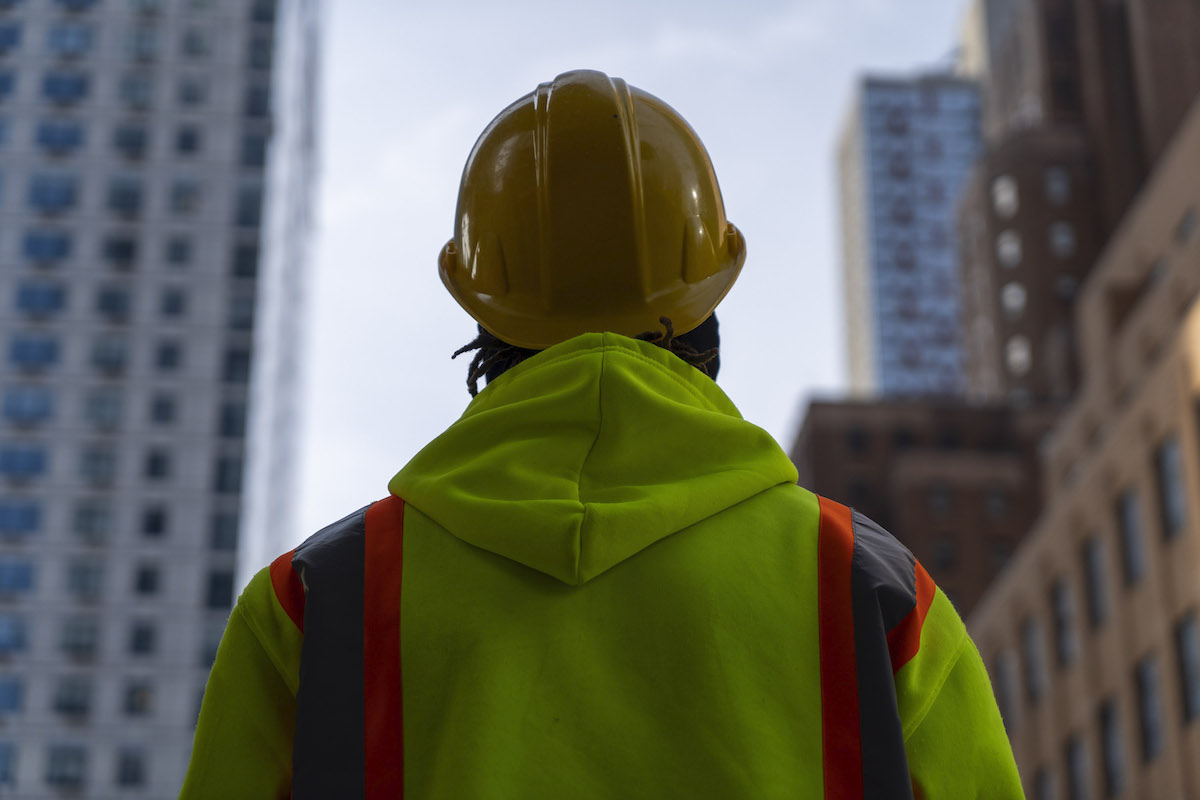

(Photo credit: Mary Conlon)
By Ana Lucía Murillo and Mary Conlon
Gustavo Enrique Ramírez’s 2020 summer vacation had finally begun. He had just wrapped up his sophomore year of high school, and was planning to work on a construction site in Nashville during the break with his older brother, Josh, who was about to go away to college.
Ramírez wanted to save up for his first car. He hadn’t learned to drive yet, but his mom had promised to teach him. He was looking forward to it, and this summer job was going to be his big chance to save up.
So on a Tuesday in June, 16 year-old Ramírez, who his family called by the affectionate nickname Kike —short for his middle name, Enrique— showed up to work at a construction site for La Quinta Inn in Nashville.
He was a laborer, and legally too young to be doing many tasks on the site. He wasn’t supposed to be on the scaffolding, but he went up anyway.
Around 2 p.m., he fell 120 feet through a 3 foot by 2 foot gap between the scaffolding and the side of the building. Two hours later, Ramírez had died.
By 6 p.m., state inspectors were at the construction site and shut it down.
According to documents from an investigation by the Tennessee Occupational Safety and Health Administration (TOSHA), Ramírez was up on the scaffolding for at least six hours that day.
Ramírez was just one of thousands of workers for whom workplace safety standards either don’t exist or aren’t properly enforced.
Construction worker fatalities and injuries are a growing problem across the U.S. Over 1,000 construction workers died from injuries received on the job in 2019, according to data from the U.S. Bureau of Labor Statistics. That’s higher than any year going back to 2008. And for a myriad of factors, death rates are higher in the southern and western U.S. than in other regions.
Construction is one of the most dangerous industries for workers in the U.S., with the private construction industry accounting for 1,061 out of 5,333 work-related fatalities in 2019 (20 percent) despite construction workers making up just 4 percent of the nation’s workforce.
While Ramírez was working that fateful shift, his oldest sister, Jenifer Enamorado Ayala, was finishing assignments due for her bachelor’s in business management program that night. Her academic week ended on Tuesdays—so she was concentrating in order to get everything in before the deadline at 10:59 p.m. Central time.
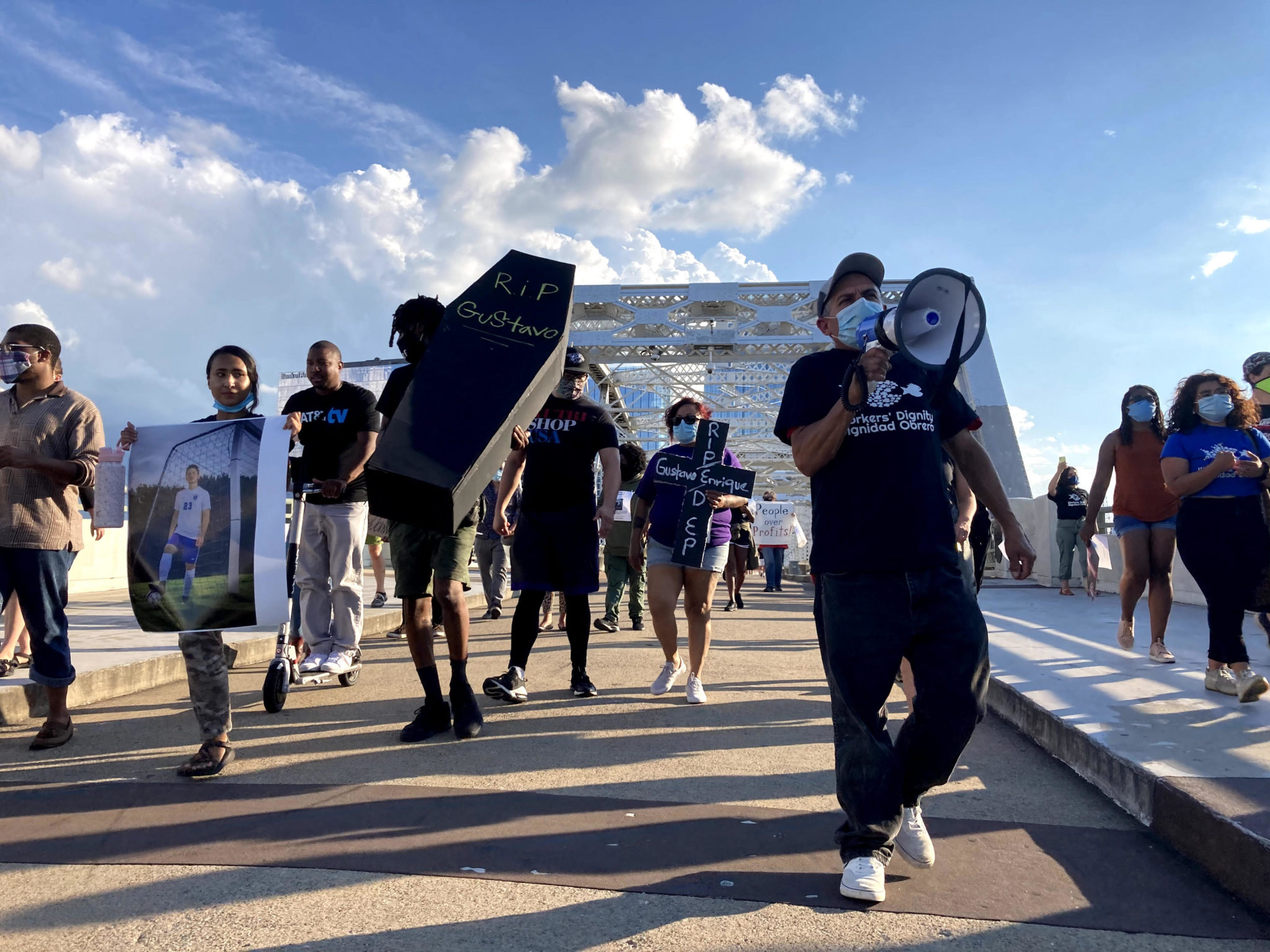

A vigil for Gustavo Ramírez takes place in Nashville in June of this year. (Photo courtesy of the Workers’ Dignity Center)
“I was rushing to get a paper written,” Enamorado Ayala said, adding that “miraculously” she hadn’t been on social media that day and missed news reports about a young man who’d died at a construction site.
When she found out later that day from her husband and brother-in-law, she and her family were devastated.
Layers of Accountability
According to TOSHA, scaffolding issues were the third most common construction site violation the federal Occupational Safety and Health Administration (OSHA) listed across the country in fiscal year 2019, showing that what happened to Ramírez was not an anomaly.
Ramírez was hired by a subcontractor, Cortez Plastering, who was hired by another subcontractor on the site, Stover and Sons. The developer, DF Chase, said they were never aware Ramírez was hired. But that doesn’t make his hiring illegitimate. These levels of separation make it hard to determine who holds primary responsibility for a worker’s safety.
The scaffolding was not correctly installed at the time of Ramírez’s fatal fall, and he had also not been trained to work on scaffolding, a task that is illegal for minors under federal OSHA standards.
Since Ramírez’s death, two subcontractors on the site have been fined a total of over $20,000 for the lack of planking and decking on the scaffolding. A lawsuit by the family is pending.
The frequency of stories like Gustavo Ramírez’s has advocates and workers around the country demanding reform, after years of diminished regulation and little oversight.
Risky Business
There is an inherent risk to much construction work, which involves heavy machinery and potentially hazardous tasks. A 2017 study by the Workers Defense Project, the University of Illinois at Chicago and the Partnership for Working Families looked at the growing precarity of construction workers in the southern U.S. They identified many causes for high injury and fatality rates, including “working at heights without fall protection, use of power tools, and exposure to intense outdoor heat.”
They also noted that workers are moving job sites frequently, leading them to need time to adjust to and gain an understanding of their new tasks and environment. “Pressure from employers to work quickly or for long hours may also contribute to construction injuries as workers become fatigued,” according to the study.
Yet the organizational and policy environment in a particular area can have a large impact on relative worker safety. Unions, for example which are more common in the Northeast and Midwest, play a large role in determining safety standards and reducing fatalities. Whereas Tennessee has one of the lowest unionization rates in the nation, New York, for instance, has the second highest rate of union membership in the country, and has almost consistently seen a lower rate of fatalities than Tennessee over the past 10 years.
In states where unions have a stronger presence, unions step in to protect workers from exploitative contractors.
“Unionized construction jobs are much safer,” said Rebecca Givan, associate professor at the School of Management and Labor Relations at Rutgers University, who studies these issues.
When access to unions is limited, “workers don’t have any protections, and it becomes a bit of a wild west in terms of injuries, and in terms of employers basically being able to have very, very unsafe workplaces with almost no consequences.”
With its high rates of unionization, that “wild west” should not be present in New York City, yet in some ways it is.The city leads in safety regulations in the state, having passed a number of protective laws in recent years. However, it continues to see a higher rate of fatalities than the national average, especially among its non-union workers.
Unions like the NY District Council of Carpenters have established schools to train their workers. In addition to their apprenticeships, safety courses and on-the-job training, they offer ongoing education.
With the advocacy of union members and in the hopes of staving off fatalities, a law was passed in New York City in 2017 which requires construction workers to obtain 30 hours of OSHA site safety training to be able to work. An additional 10 hours of required training was added in September of this year, but its implementation has been pushed back to March 2021 due to the pandemic. This is one of the most stringent safety training requirements anywhere in the country.
Currently, 10 states in the country have mandatory minimum OSHA training for all construction workers. New York state was the only one among those to require 40 hours of training; Tennessee was not on the list.
Lack of Oversight
The New York City Department of Buildings (DOB) said they have issued over 100,000 site safety training cards —the marker of a completed training course— as of October.
Some are concerned that requiring employees to get site safety training on their own unfairly places the onus on workers, and shouldn’t be something they have to pay for. It can cost up to $300.
“It is a good skill set to have, there’s no doubt. But it may or may not affect the job you’re doing. And it doesn’t relieve the employer from having to give you job specific hazard training that’s required by standards under the OSHA law and state laws,” said Debbie Berkowitz, worker health and safety program director at the National Employment Law Project, and former senior policy advisor for OSHA under Obama.
The Department of Buildings says they have seen a 20% reduction in injuries from 2018 to 2019. Deaths have remained the same.
There is clear room for improvement in inspection, oversight, training and enforcement across the country. In theory, the federal Occupational Health and Safety Administration would be at the forefront of pushing for that change.
But in its 50th year of operations, OSHA is in plain need of revitalization. Inspections on construction sites are at their lowest rate since 1980, and the number of inspectors is at the lowest number since the early 1970s. With current staffing and annual budget of less than $600 million, it would take federal OSHA 162 years to inspect every workplace in its jurisdiction just one time, according to a report by AFL-CIO. Meanwhile, penalty fines have increased nominally, doing little to incentivize stronger safety oversight from companies.
“The answer is really some kind of partnership between OSHA and state building agencies who give out permits to do construction,” says Berkowitz. “Building inspectors go out to a lot more sites and they could refer violations to OSHA, but they don’t.”
Lack of oversight and accountability is an ongoing issue in both New York and Tennessee.
“A lot of it comes from the fact that the the government agencies charged with enforcement are so hollowed out and weak, that if there are unions present, they can step up andplay some of that role. And if there aren’t unions present, nobody’s playing that role,” Givan said.
“One of the things that we tried to start when I was at OSHA under Obama,” Berkowitz said, “was a partnership with state agencies. Before they give permits to companies, they should look at their safety records. They should look at what their safety programs are for trenching, fall protection, before they give building permits.”
In Boston, an ordinance like this is already in practice, requiring builders to submit their history of OSHA violations and show that they corrected any hazards.
“You want to go after the bad actors that are cutting corners,” Berkowitz noted.
Part of the difficulty in regulating such standards is OSHA’s inconsistent reach across different states. Tennessee is one of 21 states that have a state OSHA for the private sector, as opposed to receiving federal OSHA oversight.
“The ones in the south–North Carolina, South Carolina, Tennessee–tend to be much weaker on enforcement,” Berkowitz says. “State agencies are much more beholden to the governor. And you have a Republican Governor. You have Republicans who just are not big on enforcement.”
Discrimination and Disproportionate Impact on Latinos
A lack of mandated safety training adds to the danger for workers especially in the South, and fear of workplace retaliation or of being reported to immigration authorities may also prevent employees from speaking up about feeling unsafe on a site. In 2015, 59% of Latino construction workers were not U.S. citizens, according to the Center for Construction Research and Training.
Latinos make up 18 percent of the US population, but 30 percent of construction employees. That’s a higher percentage than are employed in any other industry, and they’re overrepresented in blue-collar positions.
Raúl Morelos is a 39-year-old former construction worker living in Nashville, Tennessee. He has the easy laugh of a former shopkeeper, and when he moved to the U.S. almost two years ago, he began working in Nashville’s booming construction industry.
Less than a year into his move, he was injured on the job. He was working in residential construction and carpentry, and one day last December, he was moving a beam with another person. They were walking on top of the walls of the structure when the other worker dropped his side of the beam. The force of the drop pushed Morelos into the air and out of the house onto the ground. “As if I’d dived into the earth,” Morelos said.
Morelos was in terrible pain from the accident. His employer, a subcontractor on the site, took him to the hospital, and eventually he had surgery on his collarbone. But nearly nine months later, he’s still in such severe back pain that he can’t work. He’s filed a worker’s compensation case with the state, and is hoping to hear back soon.
In the meantime, he’s taking matters into his own hands. He joined the Workers’ Dignity Center in Nashville. The center had organized a protest demanding justice in the days after Gustavo Ramírez’s death. The local, worker-led center, opened in 2010, has already built a strong reputation for advocating for worker’s rights in the area.
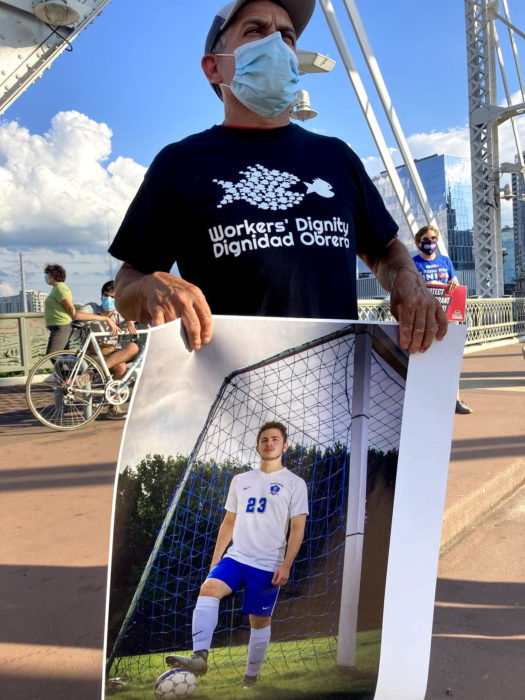

(A man holds up an image of Gustavo at a vigil in his honor in June. (Photo courtesy of the Workers’ Dignity Center)
There, Morelos found support among fellow mostly Latino and immigrant construction workers who had also experienced injuries and other forms of exploitation and wanted to fight back.
“You come to this country with many dreams, lots of projects, things you want to do. And from one day to the next, they ruin all that,” Morelos said. “In my case, some people probably wish I’d already left [back to Mexico], right? That I’d left this [case] alone as many have done. But I don’t want to leave it alone. I don’t want to become just part of a statistic.”
Too many people stay quiet, Morelos said, out of fear for deportation or worse. But then the abuse continues.
These fears aren’t unfounded. Last fall, a construction worker was deported to Honduras after an accident at a New Orleans construction site that left him and dozens of his colleagues injured, as well as three workers from the site dead. It’s believed that he was deported in retaliation after reporting construction “shortcuts” on the site to a supervisor days before the accident.
And this January, a construction contractor in Minnesota was sentenced to nearly a year in jail partially for threatening his undocumented workers with deportation if they refused to follow his orders or demanded overtime pay.
There are many obstacles to be overcome in making the construction industry safer for the most vulnerable workers—some easier than others to change. Along with colleagues and the director of the Workers’ Dignity Center, Cecilia Prado, Morelos formed a construction committee that’s working to improve conditions in the industry
Day laborer organizations throughout New York City, including Workers Justice Project in Brooklyn, do similar work to Workers’ Dignity Center in Nashville.
“We are the union of the poor,” says Gonzalo Cruz, health and safety director at Workers Justice Project, during an OSHA-30 training workshop. “We have the best labor laws in New York City, but the enforcement is not as strong.”
María Figueroa from Cornell’s Worker Institute studied the impact of mandated OSHA safety training in New York City. She credits the recent decrease in injuries there largely to worker’s rights centers, concluding that the decline can be attributed only partially to the 2017 legislation.
She found that increased access to training for vulnerable and immigrant workers contributed to greater safety awareness, ability to prevent accidents, and sense of individual empowerment.
“Their approach to labor, education and safety training is more comprehensive,” Figueroa said. “It’s really helpful because when it comes to worker safety, a lot of the workers, particularly immigrant workers, they often lack the confidence to assert their rights in the workplace.”
Workers Justice Project has over 3,000 members who pay an annual fee of $50. That includes the cost of the OSHA-30 safety training workshops, which are provided in Spanish.
“We’re trying to raise awareness among people to report, to know their rights, to not take risks in a workplace,” Cruz said. “We are reinforcing that workers recognize a danger in the workplace before an accident happens or they die.
After Gustavo Ramírez’s highly publicized death over the summer in Nashville, Prado said she began to see more and more construction workers come to the center who had been injured on the job and wanted help filing workers compensation claims.
She began a worker-led construction committee that now has around 40 active members. Morelos and his colleagues do the main legwork of sharing know-your-rights information with each other and learning to implement public pressure campaigns in order to help with their claims against their former or current employers.
Prado said initiatives like these are crucial in Tennessee, where Ramírez’s case is simply “the top of a pyramid,” and underneath are countless injuries and other OSHA violations that are never caught in the first place.
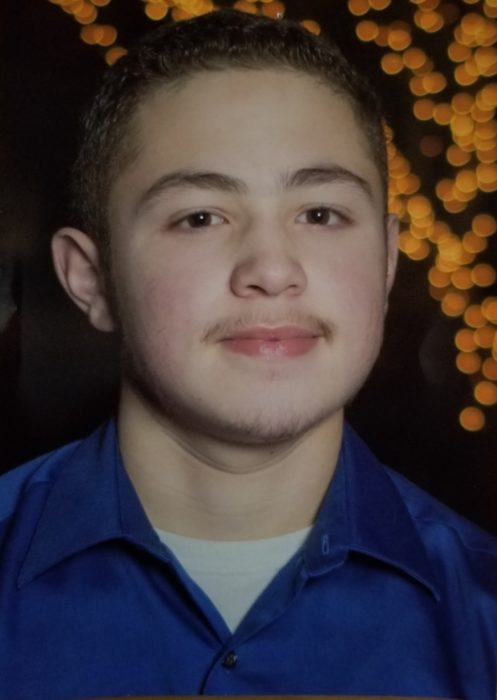

Gustavo Ramírez in a 2018 photo his parents had done. (Courtesy of Jenifer Enamorado Ayala)
But even when violations are caught, there are upper limits to the consequences for employers. In New York, the case of Carlos Mancayo was pivotal in pushing forward construction worker protections through increased accountability.
Day laborer Carlos Moncayo, 22, died in 2015 when a trench collapsed on him, burying him alive. A 2016 lawsuit found the construction company responsible for the worksite guilty of manslaughter, setting the precedent as a criminal conviction for a worker death. The accident propelled “Carlos’ Law” through the state legislature, which would increase criminal penalties against negligent developers. Carlos’ Law, however, ultimately fell short at the Senate floor.
Currently, New York contractors found criminally liable for the death of a worker face a maximum penalty of just $10,000—the same amount DOB implemented in March for contractors who violated the freeze on non-essential worksites.
NY State Assemblywoman Catalina Cruz said she is currently working with the Manhattan DA’s Construction Fraud Task Force to rethink similar legislation. Cruz was formerly the director of Governor Cuomo’s Exploited Workers Task Force.
“I think one of the reasons why Carlos’ Law has not passed is because the people that continue to die are undocumented immigrants or low-wage workers,” Cruz said. “If you had middle-class white New Yorkers dying in the workplace in the same way that you have these folks dying in the workplace, that happen to be undocumented and low-wage workers, you’d see a completely different take.”
Ramírez wasn’t undocumented or a low-wage worker. He was a very normal American highschooler. But his death is still indicative of the unequal impact unsafe construction work conditions have on Latinos. Ramírez’s sister said he was the baby of the family, extremely popular at school and dearly loved by everyone, from his friends to his nieces and nephews.
“He was always making sure that other people felt included,” Enamorado Ayala said.
Her daughter has had panic attacks since her uncle’s passing. “For a few months there, my daughter was terrified that my husband and I would leave for work and not come back.”
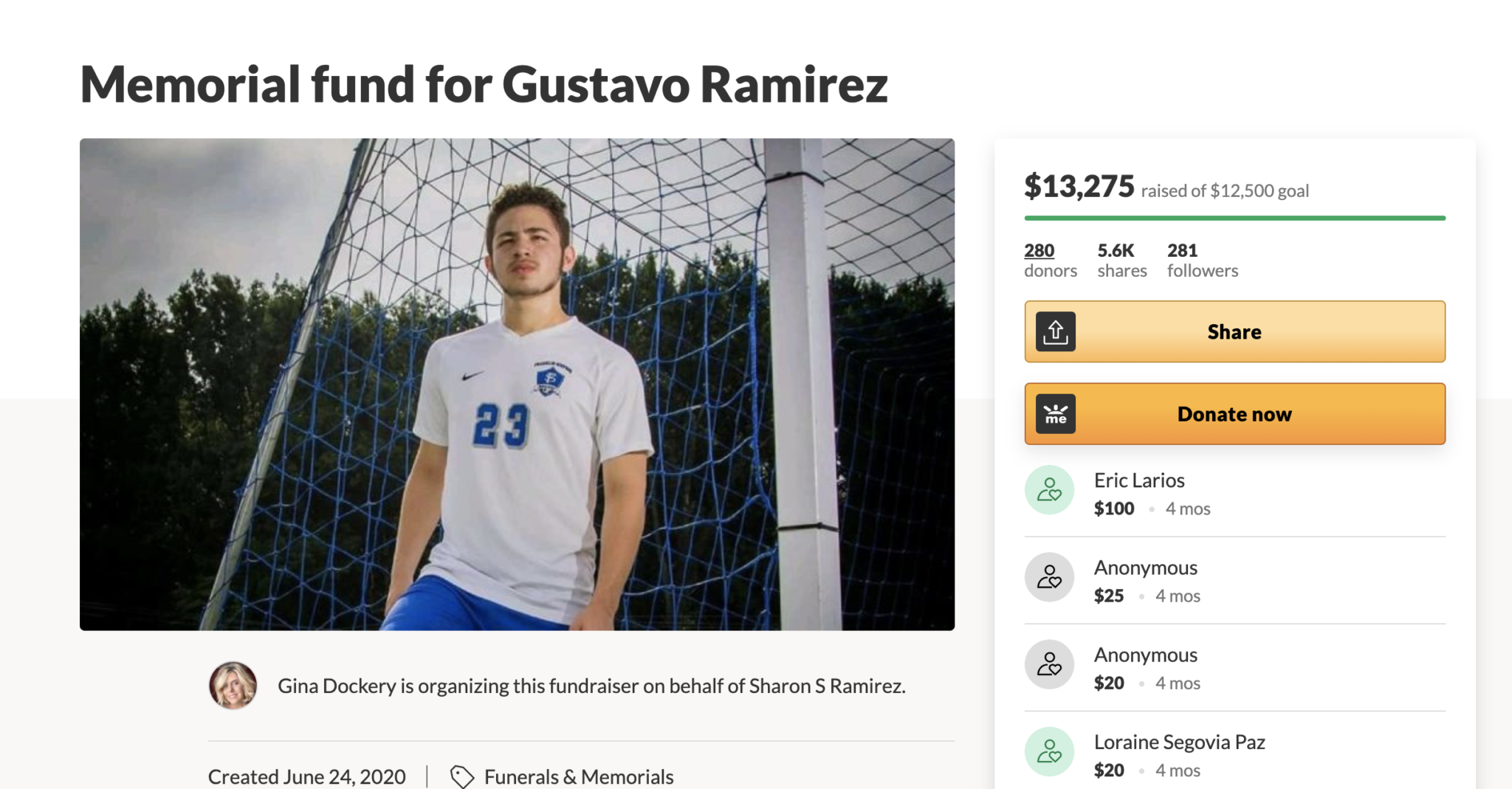

The mother of one of Gustavo Ramírez’s classmates, Gina Dockery, set up a Go Fund Me to help the family with funeral expenses. (Screenshot)
Ramírez’s parents moved out of the house that they had just recently purchased before their son’s death. They couldn’t manage being alone anymore, and the memories were too much for them. They’ve since moved in with Enamorado Ayala.
The long-term consequences of Ramírez’s death will reverberate well beyond this year. It’s well-documented that parents who have lost a child suffer poorer mental and physical health for decades beyond the actual date of loss, to say nothing of the traumatic effect on extended family and friends. All of this is happening while there are already increasing rates of anxiety, depression and PTSD as a cause of the COVID-19 pandemic.
Ramírez’s family has filed a lawsuit against the contractor, sub-contractor, and others who they say aided in getting Ramírez the job at the construction site. It alleges that the company that trained Ramírez didn’t include age requirements for working on scaffolding in its training, and that the scaffolding was unsafe and led to Ramírez’s deadly fall. The suit doesn’t specify how much the family is seeking in damages.
Enamorado Ayala said the outcome won’t change what’s already happened.
“There is no possible peace that can be given to us. There’s a hole now in our family that can’t be filled by anyone,” she explained. “On top of the pain that we feel, we must live with the impending pain of another family that will lose another brother, father, uncle, or sister, gender nonspecific. We are well aware of it. Someone else will feel this eventually as well.”
***
Ana Lucía Murillo is a bilingual print and audio journalist based in Washington, D.C. She reports on business, immigration and politics. She has a master’s in journalism from the Craig Newmark Graduate School of Journalism at CUNY. Her work has appeared in the Daily Beast, Washington City Paper, Latino Rebels, Bklyner, and elsewhere. You can follow her on Twitter at @analuciamur.
Mary Conlon is a documentary photographer and filmmaker based in New York City. She has a master’s in Spanish-language journalism at the CUNY Graduate School of Journalism. Her written and visual stories have been published by Univision, City Limits, the NYCity News Service, and more. You can follow her on Twitter at @MaryEConlon and Instagram at @meccymec.



Great article, unfortunately the slaughter continues in #MortuaryCity ?